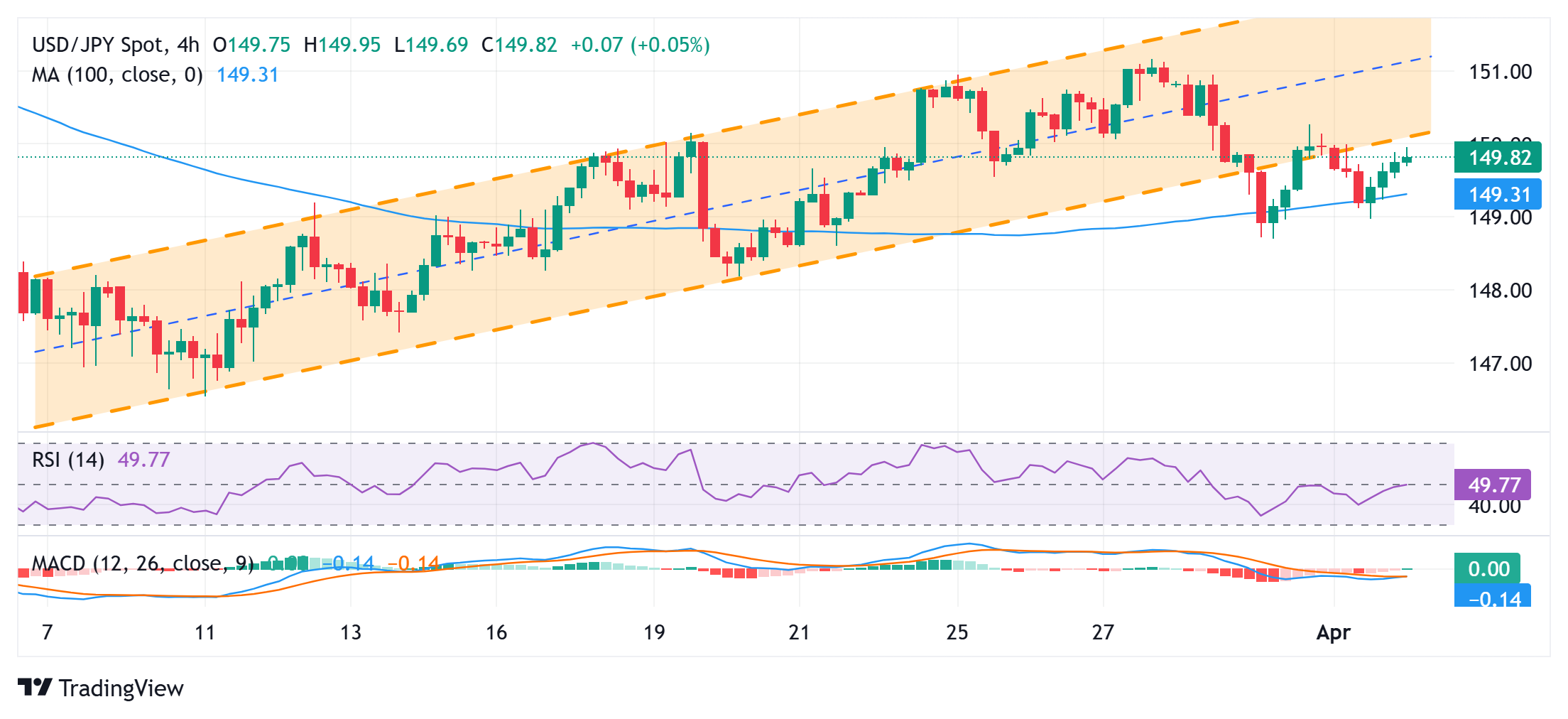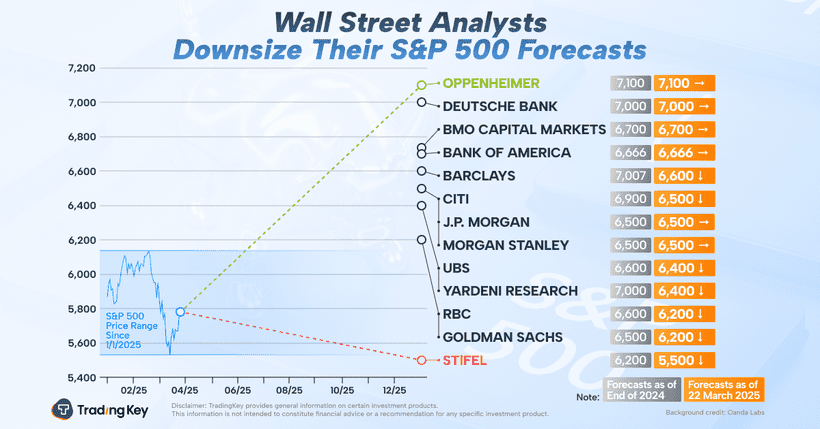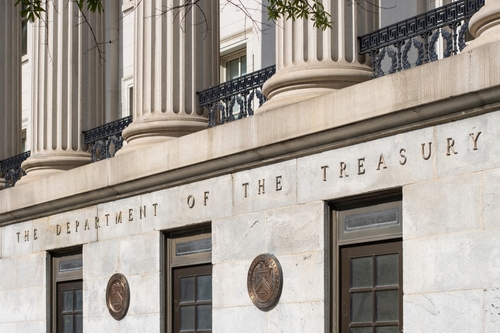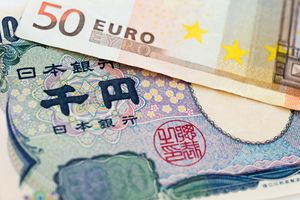Japanese Yen trades with negative bias against USD ahead of Trump’s reciprocal tariffs

- The Japanese Yen drifts lower amid concerns that Trump’s tariffs would affect Japan’s industries.
- The divergent BoJ-Fed policy expectations should limit deeper losses for the lower-yielding JPY.
- Traders might also refrain from placing aggressive bets ahead of Trump’s tariffs announcement.
The Japanese Yen (JPY) struggles to capitalize on the previous day's modest gains against its American counterpart and attracts fresh sellers during the Asian session on Wednesday. The USD/JPY pair, however, remains confined in a range held since the beginning of this week as traders await a fresh catalyst before positioning for the next leg of a directional move. Hence, the focus will remain glued to US President Donald Trump's reciprocal tariffs announcement later today.
In the meantime, speculations that a tariff-driven economic slowdown might force the Bank of Japan (BoJ) to keep the policy steady for the time being undermine the JPY. Investors, however, seem convinced that the BoJ will continue raising interest rates amid signs of broadening inflation in Japan. This marks a big divergence in comparison to the growing acceptance that the Federal Reserve (Fed) will resume its rate-cutting cycle in June and should support the lower-yielding JPY.
Japanese Yen bulls remain on the sidelines amid market anxiety over Trump’s reciprocal tariffs
- Asian equity markets tracked the overnight gains on Wall Street ahead of the impending reciprocal tariffs announcement from US President Donald Trump on Wednesday, undermining the safe-haven Japanese Yen.
- Meanwhile, Trump dashed hopes that the levies would be limited to a smaller group of countries with the biggest trade imbalances and said on Sunday that so-called reciprocal tariffs would essentially include all nations.
- Furthermore, worries that the new levies would have a far-reaching impact on Japan's key industries forced investors to scale back their expectations that the Bank of Japan would raise policy rate at a faster pace.
- However, the incoming macro data, including strong consumer inflation figures from Tokyo released last Friday, keeps the door open for further interest rate hikes by the BoJ and helps limit deeper losses for the JPY.
- The Federal Reserve, on the other hand, remains in an uncomfortable position on the back of rising prices and slowing business activity, which implies that the economy could be heading toward stagflation.
- The concerns were further fueled by data showing that the manufacturing sector contracted for the first time in three months and inflation at the factory gate jumped to the highest level in nearly three years.
- In fact, the ISM Manufacturing Purchasing Managers Index (PMI) fell to 49 from 50.3 in February. Moreover, the Employment Index highlights a decrease in the sector's payrolls at an accelerating pace.
- Adding to this, the Job Openings and Labor Turnover Survey (JOLTS) revealed that the number of job openings on the last business day of February stood at 7.56 million, down from 7.76 million in January.
- The markets are currently pricing in the possibility that the Fed would lower borrowing costs by 80 basis points by the end of this year, which fails to assist the US Dollar in attracting any meaningful buyers.
- Meanwhile, the divergent BoJ-Fed expectations could further narrow the rate differential between Japan and the US. This, in turn, should limit losses for the lower-yielding JPY and cap the USD/JPY pair.
- Traders now look forward to Wednesday's US economic docket – featuring the ADP report on private-sector employment and Factory Orders – for some impetus ahead of Trump's tariffs announcement.
USD/JPY needs to move beyond 150.25 area, or weekly high for bulls to seize near-term control

From a technical perspective, the USD/JPY pair has been showing resilience below the 100-period Simple Moving Average (SMA) since the beginning of this week. The subsequent move up could favor bullish traders, though neutral oscillators warrant some caution. Moreover, the recent breakdown below a multi-week-old ascending channel makes it prudent to wait for strong follow-through buying before positioning for any meaningful gains.
In the meantime, the weekly high, around the 150.25 area, could act as an immediate hurdle. A sustained strength above could lift the USD/JPY pair beyond the 150.75-150.80 hurdle, towards the 151.00 mark. This is followed by the March monthly swing high, around the 151.30 region and a technically significant 200-day SMA, currently pegged near the 151.60 zone, above which spot prices could reclaim the 152.00 mark and climb further to the 152.45-152.50 region en route to the 100-day SMA, around the 153.00 round figure.
On the flip side, the 100-period SMA on the 4-hour chart, currently around the 149.30-149.25 area, followed by the 149.00 mark and the 148.70 region, or the weekly swing low, could offer support to the USD/JPY pair. A convincing break below, however, will be seen as a fresh trigger for bearish traders and make spot prices vulnerable to resume a well-established downtrend witnessed over the past three months or so.
Japanese Yen FAQs
What key factors drive the Japanese Yen?
The Japanese Yen (JPY) is one of the world’s most traded currencies. Its value is broadly determined by the performance of the Japanese economy, but more specifically by the Bank of Japan’s policy, the differential between Japanese and US bond yields, or risk sentiment among traders, among other factors.
How do the decisions of the Bank of Japan impact the Japanese Yen?
One of the Bank of Japan’s mandates is currency control, so its moves are key for the Yen. The BoJ has directly intervened in currency markets sometimes, generally to lower the value of the Yen, although it refrains from doing it often due to political concerns of its main trading partners. The BoJ ultra-loose monetary policy between 2013 and 2024 caused the Yen to depreciate against its main currency peers due to an increasing policy divergence between the Bank of Japan and other main central banks. More recently, the gradually unwinding of this ultra-loose policy has given some support to the Yen.
How does the differential between Japanese and US bond yields impact the Japanese Yen?
Over the last decade, the BoJ’s stance of sticking to ultra-loose monetary policy has led to a widening policy divergence with other central banks, particularly with the US Federal Reserve. This supported a widening of the differential between the 10-year US and Japanese bonds, which favored the US Dollar against the Japanese Yen. The BoJ decision in 2024 to gradually abandon the ultra-loose policy, coupled with interest-rate cuts in other major central banks, is narrowing this differential.
How does broader risk sentiment impact the Japanese Yen?
The Japanese Yen is often seen as a safe-haven investment. This means that in times of market stress, investors are more likely to put their money in the Japanese currency due to its supposed reliability and stability. Turbulent times are likely to strengthen the Yen’s value against other currencies seen as more risky to invest in.





